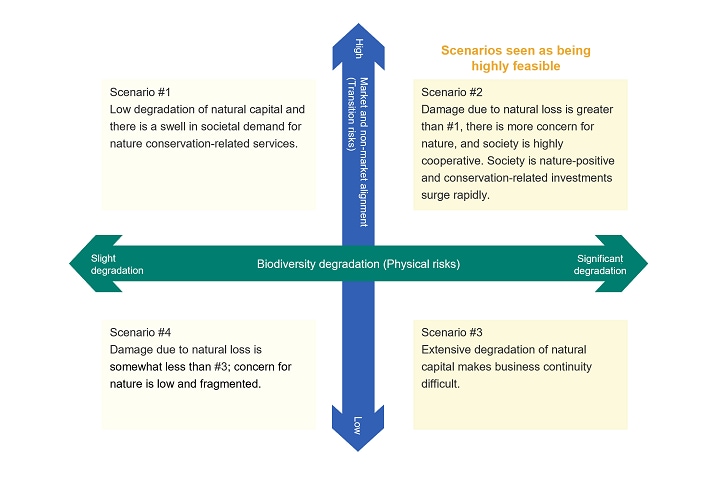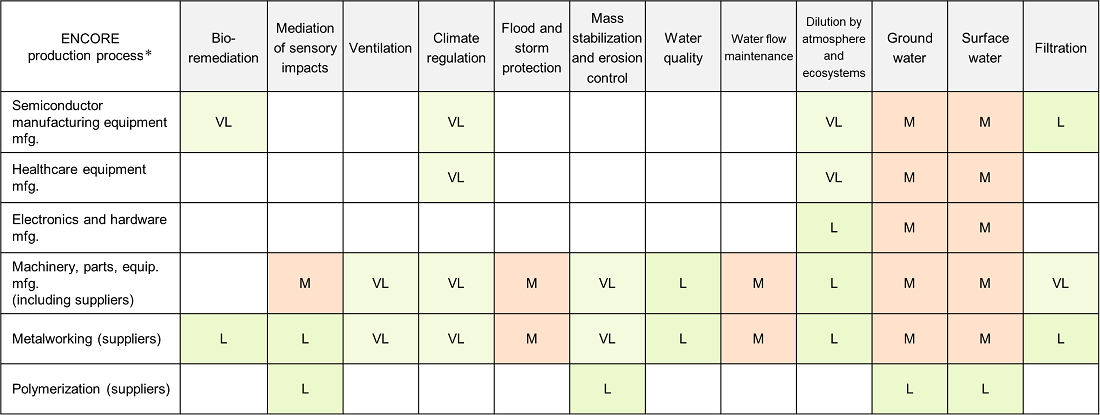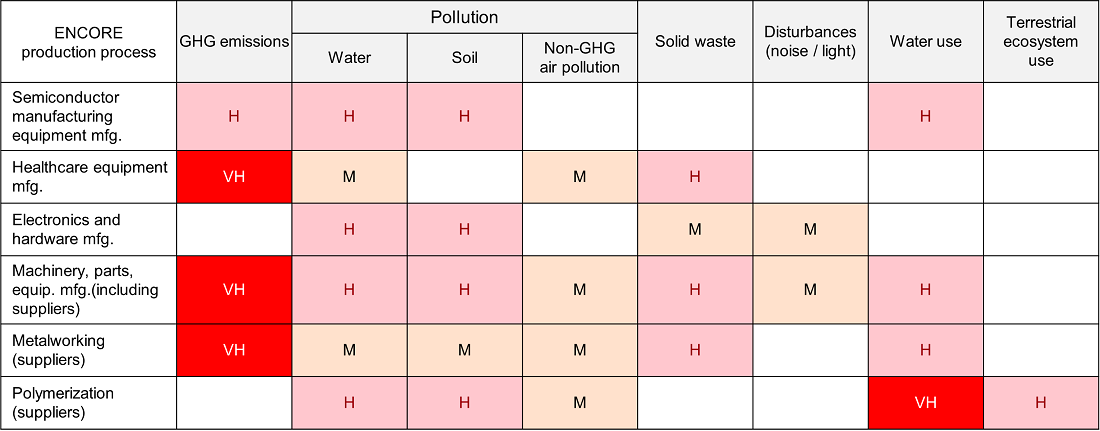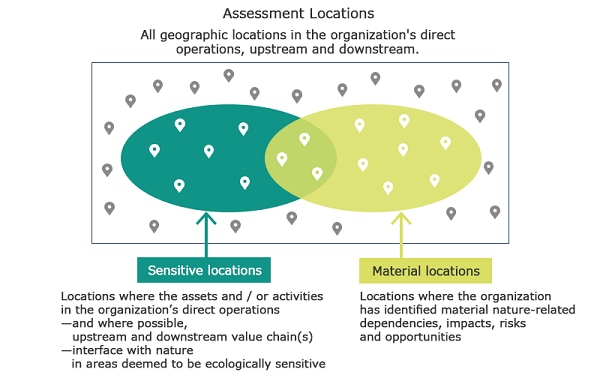Information Disclosure Based on TNFD Recommendations: Strategy
This section provides information on the results of the assessment of risks and opportunities, and information about nature-related opportunities for priority locations and business activities. These were identified for direct operations and key suppliers in the Hitachi High-Tech Group’s value chain using the LEAP approach.
The information disclosed on the website is a digest. For details, please refer to the TNFD Report (PDF format, 1.45 MB).
Scenario Analysis
As part of our efforts to identify risks and opportunities, we have conducted scenario analyses.
Four scenarios were created based on different degrees of transition and physical risks, with two of the scenarios (Scenario #2, #3) taking into account consistency with the TCFD being selected: A 1.5 °C scenario and a 4 °C scenario.
For each scenario, we used the IPCC Sixth Assessment Report (AR6) as a reference, and based on climate change and socioeconomic scenarios, we conducted an analysis of seven forces based on the five forces of the threat of new entrants, bargaining power of sellers, bargaining power of buyers, threat of alternative goods and services, and competitive rivalry, and the additional two forces of government, and investors and finance, which are strongly connected to climate change.

| Anticipated future environment | ||
|---|---|---|
| 1.5 °C scenario | 4 °C scenario | |
| Scenario #1 / #2 | Scenario #3 / #4 | |
| TCFD | IEA NZE 2050 SSP1-1.9 |
IEA STEPS IEA CPS SSP5-8.5 |
| TNFD | Moderate degradation of nature. #1: High concern for and positivity toward nature. Tighter nature-related regulations. (2050-2100) #2: High concern for and positivity toward nature. Tighter nature-related regulations. (Present-2050) |
Extensive loss of nature and severe damage. #3: Environmental protection efforts given low priority. (2050-2100) #4: Environmental protection efforts given low priority. (Present-2050) |
Scenario #2:
Biodiversity is already degraded due to climate change resulting from rising temperatures. Even if the temperature increase is contained to 1.5 °C at the end of this century, the effects are already underway, with degradation of the natural environment in terrestrial, freshwater, and other areas shown in the moderate to high range due to increased physical risks from climate change.
This scenario is considered the most feasible if the most desirable human countermeasures are put in place in the future. (Present-2050)
Scenario #3:
Climate change measures have failed and natural capital is severely degraded. At the end of this century we have reached a temperature increase of 4 °C or more and it is difficult to adapt. Human health outcomes are also at very high risk, with significant impacts expected in all natural areas. (2050-2100)
Assessment of Risks and Opportunities
Using scenario #2 from our scenario analysis, anticipated risks were each quantified regarding their impact and possibility of occurrence and evaluated on a three-grade scale (large, medium, and small), and measures for their management were considered.
Risks expected to have an impact within the scope of the assessment
| Category | Factors / Areas of impact (Main dependencies and impacts) |
Description of risks [Financial impacts] | Time frame |
Risk assess. |
Risk management measures | |
|---|---|---|---|---|---|---|
| Physical risks | Acute | Changes in water quantity, quality, and temperature / Freshwater (Dependency: Water supply) |
The Hitachi High-Tech Group uses water for cleaning and cooling precision parts and equipment, air conditioning, cleaning, and domestic water use, etc. The Group expects increased costs in responding to changes in water quantity and quality, as well as an impact on production volume, and in the worst case, the shutting down of operations. [Operating costs, decreased sales] |
Short Medium Long |
Medium |
|
| Acute / chronic | Destruction of wastewater treatment facilities or discharge of contaminated water due to heavy rainfall or flooding / Freshwater, ocean (Dependency: Water flow maintenance; Impact: Water pollution) |
Deterioration of freshwater ecosystems due to pollutants discharged by the organization or other stakeholders is expected. [Community compensation costs, contamination cleanup costs] |
Short Medium Long |
Large |
|
|
| Chronic | Increase in extreme weather events due to GHG emissions and global warming / Atmosphere (Dependency: Mitigation of natural disasters; Impact: GHG emissions) |
Inundation caused by natural disasters such as torrential rains and flood are expected to affect production activities. Such cases could cause restoration costs, delayed deliveries, and suspended operations. Delivery delays or shutdowns due to supply disruptions from suppliers are also possible. [Operating costs, decreased sales] |
Long | Medium |
|
|
| Change in risk of decline or extinction of species / Terrestrial (Dependency: Reduction of noise, etc.; Impact: ecosystem use) |
If there is a reduction in acoustic mitigation due to changes in vegetation caused by climate change, it will be necessary to address the increased cost of capital investment in soundproofing walls and the potential loss of reputation in surrounding neighborhoods. [Capital investment costs, neighborhood response costs] |
Medium | Small |
|
||
| Transition risks | New regulations | Nature-related regulations / Atmosphere, freshwater, ocean, terrestrial | When sales exceed thresholds regulated in a given area, the Group may be required to disclose information on the status of its biodiversity measures, along with the results of its assessment of its dependencies, impacts, risks, and opportunities. [Regulatory compliance costs, decreased sales if standards are not met] |
Short Medium Long |
Large |
|
| Lawsuits | Social responsibility for adverse effects on natural capital / Atmosphere, freshwater, ocean, terrestrial | Deterioration of freshwater ecosystems due to pollutants discharged by the organization or other stakeholders is expected. [Community compensation costs, contamination cleanup costs] |
Long | Medium |
|
|
| Markets | Increased customer demand concerning natural ecosystems / Atmosphere, freshwater, ocean, terrestrial | If there are products manufactured by the Group that are not recyclable, use more water or resources, or generate more waste at the customer's end, there may be increased customer demands for ecological considerations related to these products. [Costs of responding to customer demands; decreased sales if those demands cannot be met] |
Medium Long |
Medium |
|
|
| Reputation | Brand degradation due to lack of response to natural ecosystems | As a company in the Hitachi Group, we are seen as having a great deal of social responsibility. If we are judged to lack consideration for biodiversity, the credibility and reputation of our parent company, Hitachi, Ltd. and supporting financial institutions may deteriorate, and pressure may increase from outside parties. [Costs of responding to stakeholder requests; decreased sales and loss of human resources if requests cannot be met] |
Medium Long |
Medium |
|
|
* Risk assessment is carried out based on two axes: probability of occurrence over an assumed time frame and degree of impact.
Identified Nature-related Opportunities
Using scenario #2 from our scenario analysis, anticipated opportunities were each quantified regarding their possibility of occurrence and evaluated on a three-grade scale (large, medium, and small).
Opportunities expected to have an impact within the scope of the assessment
| Category | Factors / Areas of impact | Description of opportunities [Financial impacts] | Time frame | Opp. assess. |
|---|---|---|---|---|
| Resource efficiency | Reduction of water consumption through water-saving equipment upgrades / Freshwater | The Group is working to reduce water consumption and improve water use efficiency by improving productivity and upgrading to water-saving equipment. Continuation of these efforts is expected to improve water-related operating costs and increase profitability through improved productivity. [Increased sales, cost reductions] |
Short Medium Long |
Large |
| Products and services | Development of products that reduce CO2 emissions / Atmosphere | We are promoting environmentally-friendly design (eco-design) to comply with stricter environmental regulations. Eco-design is a process that identifies measures to reduce environmental impact by conducting environmentally-conscious design assessments and life cycle assessments (LCA) on products and evaluates the measures at each life stage of products for the three indicators of CO2 emissions, water consumption, and waste generation through LCA calculations. The Group creates and promotes a list of candidate eco-design products through evaluations and development conducted starting from the concept stage. The development of products that lead to reduced GHG emissions through the above initiatives provides an opportunity to increase sales. [Increased sales] |
Short Medium Long |
Large |
| Development of products that reduce resource use / Freshwater | Large | |||
| Markets | Acquiring new markets by developing technologies useful for ecosystem conservation, etc. / Freshwater, terrestrial, ocean, atmosphere | The development of solutions that are useful for monitoring natural ecosystems and technologies that do not threaten ecosystems will lead to the formation of new markets and higher sales. [Increased sales] |
Short Medium Long |
Large |
| Resource efficiency | Realization of resource efficiency and stable procurement by increasing rates of use of recycled materials and reuse of water / Freshwater, terrestrial | Increasing resource efficiency in the manufacture of our products will lead to stable procurement and cost reductions in the event of resource price hikes. [Increased sales, cost reductions] |
Medium | Large |
| Capital flow and financing | Participation in financial markets focused on natural capital / Atmosphere, freshwater, ocean, terrestrial | Disclosure and response based on the TNFD framework will enable access to nature-related green funds, bonds, and loans from financial markets. [Increased capital] |
Medium | Medium |
| Resilience | Direct restoration, conservation, and protection of ecosystems and habitats / Terrestrial | The Group conducts biodiversity conservation activities at its directly operated business sites. One example is the 44,000-square-meter forest at Hitachi High-Tech Science Fuji Oyama Works, named the Woodlands of Hitachi High-Tech Science. Aiming to coexist with nature and as a member of the local community, Hitachi High-Tech Science has been engaging in this project since 2015, the goal of which is to return the forest to its original state as a wooded area with which people in the area once lived in harmony. Using plants native to the region, the company will engage in the large-scale conversion of human-planted cedar and cypress forests into broadleaf forests over a period of approximately 50 years. The company’s forest maintenance activities include the extermination of invasive plants and the placement of insect hotels, which provide homes for insects. Employees also participate, and the presence of rare plants has been confirmed on the premises. Efforts such as this are expected to restore ecosystems and help stabilize ecosystem services, thereby leading to increased sales by gaining the trust of stakeholders. [Improved sales] |
Medium Long |
Large |
| Markets | Technological innovation that reduces negative impacts on nature and increases positive impacts / Atmosphere, freshwater, ocean, terrestrial | The Group will continue to develop nature-positive products and technologies, including technological innovations that reduce impacts on nature and increase positive impacts. Success will lead to a reduction of the burden on, and the restoration of, natural ecosystems, as well as increased sales through new products and technologies. [Increased sales] |
Short Medium Long |
Large |
* Opportunities are evaluated on two axes: "probability of occurrence" and "degree of impact" on the assumed time axis.
See below for initiatives that will have a positive effect on business and nature with regard to the opportunities identified.
Evaluation of Nature-related Dependencies and Impacts
Heatmaps of Dependencies and Impacts
The business activities of the sites assessed, including direct operations and suppliers, were organized and assessed using the ENCORE tool to create heatmaps. The following findings were made regarding the dependencies and impacts of the Hitachi High-Tech Group on its value chain.
- Dependencies: Both direct operations and suppliers have a moderate dependency on “Groundwater" and “Surface water," while suppliers alone have a moderate dependency on “Flood and storm protection" and "Water flow maintenance."
- Impacts: Both direct operations and suppliers have a very high impact on "GHG emissions," and also have high impacts on “Water pollution," “Soil contamination," “Solid waste," and “Water use."
Heatmap of Dependencies
VH: Very High, H: High, M: Moderate, L: Low, VL: Very Low

Heatmap of Impacts

*
This analysis uses ENCORE's classification (GICS) up to June 2024.
GICS is an abbreviation for Global Industry Classification Standard. It is an industry classification jointly developed by S&P of the United States and MSCI (Morgan Stanley Capital International) in 1999.
Selection of Priority Locations
Definition and Selection Method of Priority Locations
In the LEAP approach, sites located in sensitive locations or material locations are designated as priority locations.
■ Assessment for Sensitive locations
In line with the definition of sensitive locations, we assessed the analysis results of the assessment tool and the registration status with OECM* and scored them according to our own scale.
■ Assessment for Material locations
Material locations were scored using the following criteria.
- Sectors assessed as high impact in ENCORE
- Sites exposed to water-related risks as disclosed in our CDP water risk responses
- Assessment in the Hitachi Environmental Management Classification Survey conducted by the Hitachi Group
- Volume of water withdrawal
Ultimately, Priority Locations were selected based on the total scores of Sensitive locations, and Material locations.

Source: Guidance on the identification and assessment of nature-related issues: the LEAP approach (p. 61)
* OECM:Abbreviation for Other Effective area-based Conservation Measures. Areas that contribute to biodiversity conservation outside of protected areas.
Priority Locations
Sixteen direct operations and six suppliers were selected as priority locations (see TNFD Report (PDF format, 1.45 MB)for details).
Some of our priority location initiatives are presented below:
